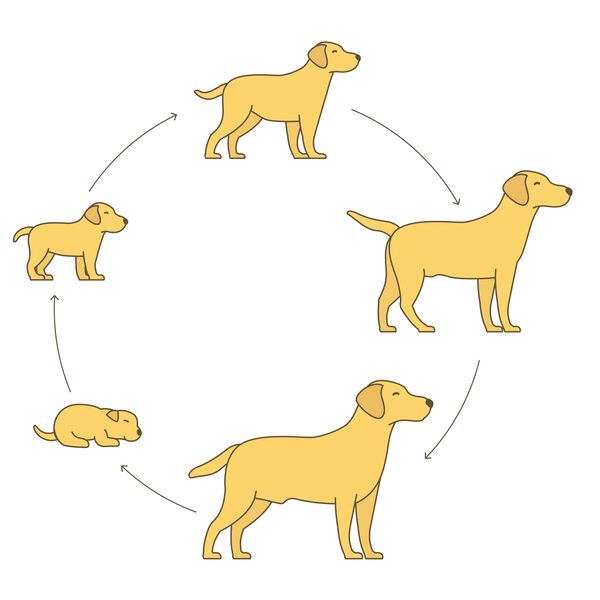Dogs are one of the most beloved pets worldwide, and watching them grow from playful puppies to mature adult dogs is a beautiful experience for any pet owner. In this article, we’ll explore the stages of a dog’s growth, from their early puppy days to their adult life, providing insights into their development, behavior, and how you can best care for them during each phase.

The puppy stage is one of the most exciting and delicate times in a dog’s life. It’s during these early weeks and months that they begin to develop their personalities, habits, and health.
Puppies are born blind, deaf, and unable to regulate their body temperature. As they grow, they go through rapid physical changes, gaining strength and mobility. By 3 weeks, their eyes and ears open, and they begin to explore their surroundings.
1-4 weeks: The early weeks are crucial as puppies start to learn from their mother and littermates. They begin to develop basic motor skills and socialization.
4-8 weeks: At this point, puppies begin to play, learn to interact with people and other dogs, and experience their first tastes of solid food.
As puppies grow, they develop different behavioral traits. Early socialization and positive experiences with people, other pets, and new environments are essential. Training during this period will help shape your dog’s future behavior.
The first year of a dog's life is full of growth and change. Not only are they growing physically, but their mental and emotional development is in full swing.
By the time your dog reaches 6 months, they will have gone through a significant growth spurt. Most dogs are about half their adult size by this point, although large breeds will continue to grow for longer.
3-6 months: This is the stage when your puppy might begin to show signs of independence and might test boundaries, so early training and socialization are key.
6-12 months: Dogs continue to mature physically and start resembling their adult form, although they still have plenty of energy and curiosity.
Puppies begin to form stronger bonds with their family, recognize their name, and respond to commands. Consistency is essential during this stage, as puppies learn the basics of obedience and household rules.
Around 1 year old, many dogs enter their adolescence phase, similar to teenage years in humans. They may exhibit more independence, energy, and sometimes challenging behaviors.
Increased energy levels: Adolescent dogs often seem more energetic than puppies and need more exercise.
Testing boundaries: They may test their limits and become a bit stubborn. Consistent training and positive reinforcement can help guide them through this phase.
During this phase, dogs may also go through hormonal changes. This is the time when many dogs experience their first heat cycle (for females) or become fully sexually mature (for males). Depending on the breed, they may also reach their full size during adolescence.
Around the age of 2 years, most dogs are considered adults. However, this transition period can vary based on breed and individual development.
Smaller breeds: Typically reach full maturity by around 12-18 months.
Larger breeds: May not reach full maturity until 2-3 years due to their slower growth rate.
Adult dogs tend to be calmer and less excitable compared to their younger years. They have a better understanding of their environment and their place in the family structure. They may also be more responsive to training and commands.
Even though your dog is now an adult, training and socialization should continue throughout their life.
Dogs are lifelong learners, and consistent training helps maintain a good relationship and ensures that they are well-behaved. Basic commands like “sit,” “stay,” “come,” and “leave it” should be reinforced throughout your dog’s life.
Socializing your dog is just as important in adulthood as it was during puppyhood. Meeting new people, dogs, and environments helps keep your dog confident and comfortable in various situations.
As your dog approaches their senior years (around 7 years for smaller breeds and 5 years for larger breeds), their needs change. Senior dogs may experience a decline in energy, vision, and hearing, and may require more care.
Older dogs may develop conditions like arthritis, dental issues, or cognitive dysfunction syndrome (similar to dementia in humans). Regular vet checkups are essential to monitor their health and make adjustments to their diet and exercise routine.
Exercise: Senior dogs may not need as much exercise as younger dogs, but daily walks and mental stimulation are still important.
Diet: Senior dogs may benefit from a special diet to support joint health and overall well-being.
From a playful puppy to a wise senior dog, a dog’s life is a journey full of changes, growth, and adaptation. Throughout each stage, it’s essential for pet owners to provide love, training, proper care, and attention to ensure that their dog lives a long, healthy, and happy life.
Dogs go through many stages in their life, from the early days as a curious puppy to their transition into adulthood and senior years. Understanding these stages and knowing how to care for your dog at each phase ensures that your dog will thrive throughout their life. Whether you're raising a puppy or caring for an older dog, the bond you share will only grow stronger with time.
By providing the right environment, training, and love, you can help your dog become a well-rounded, happy adult dog that will be your loyal companion for years to come.
animal tags: dog
We created this article in conjunction with AI technology, then made sure it was fact-checked and edited by a Animals Top editor.